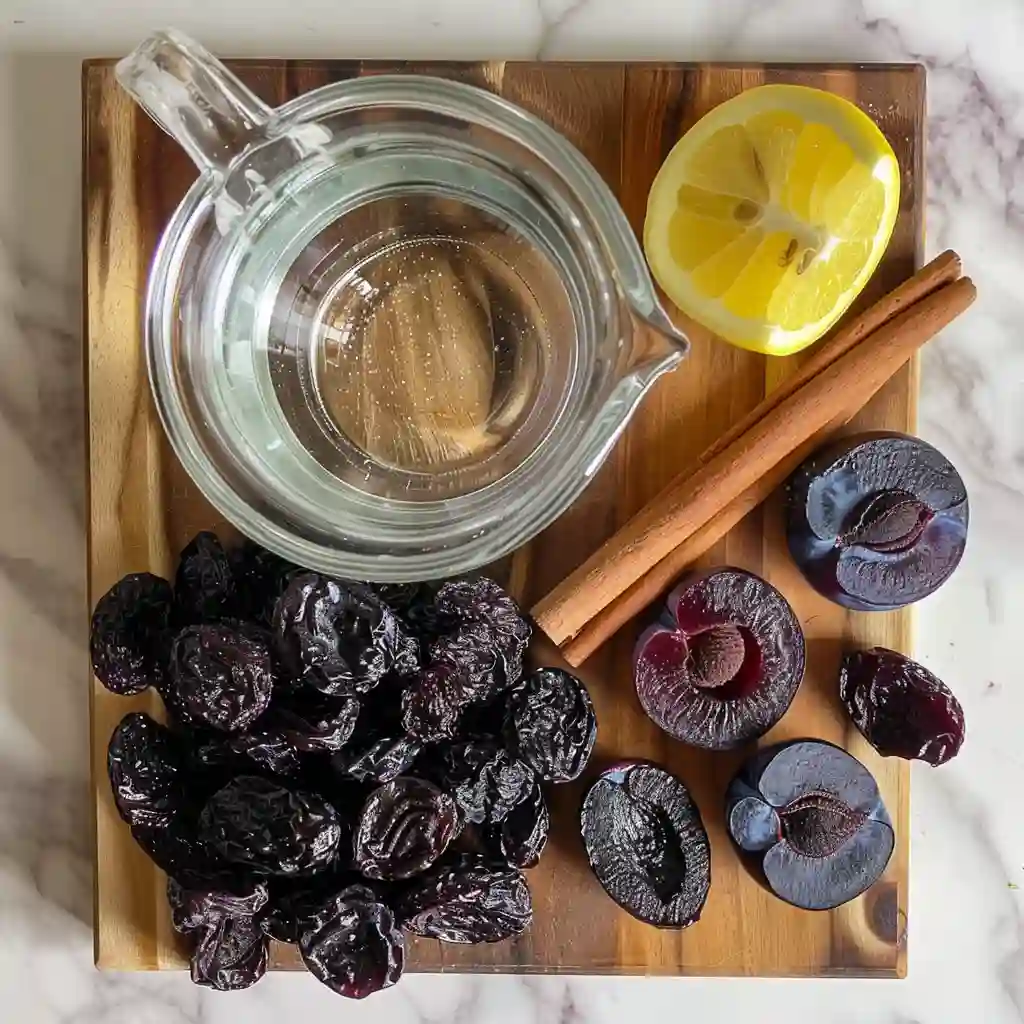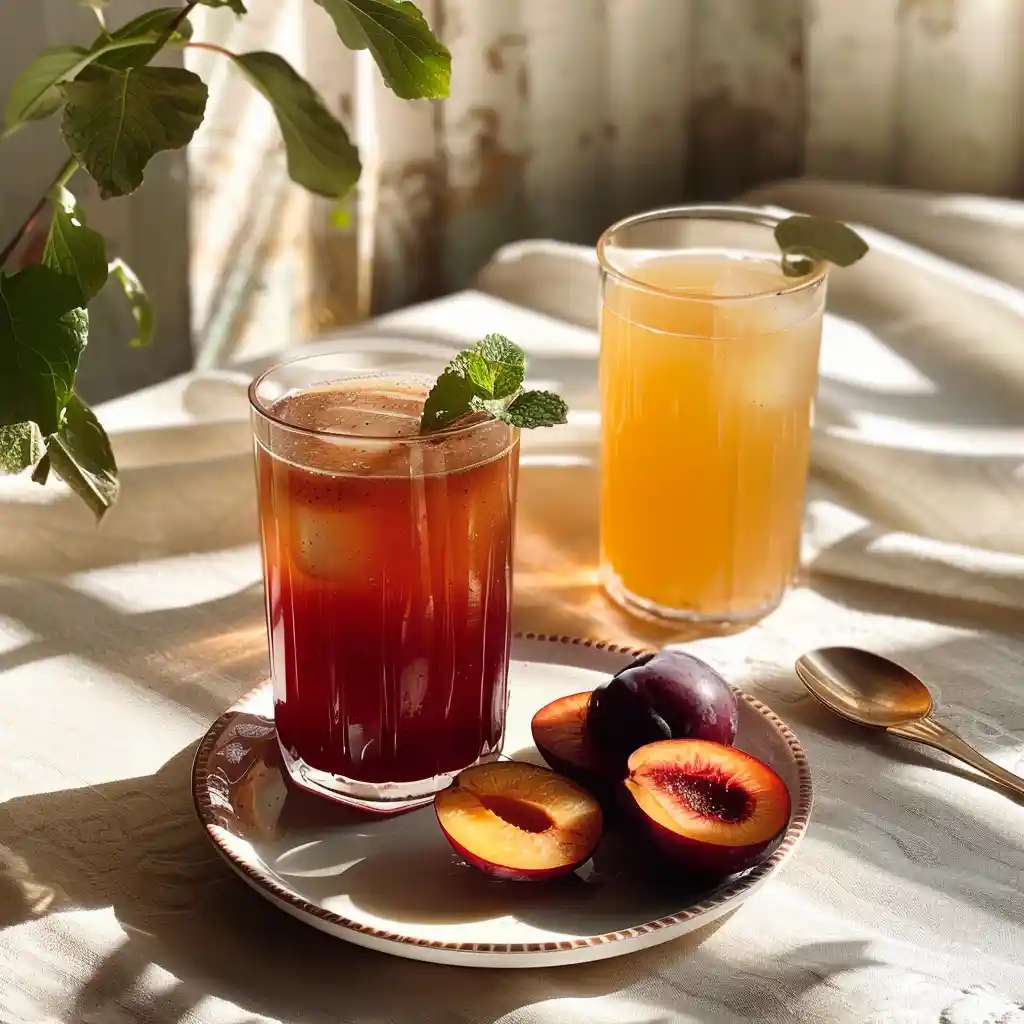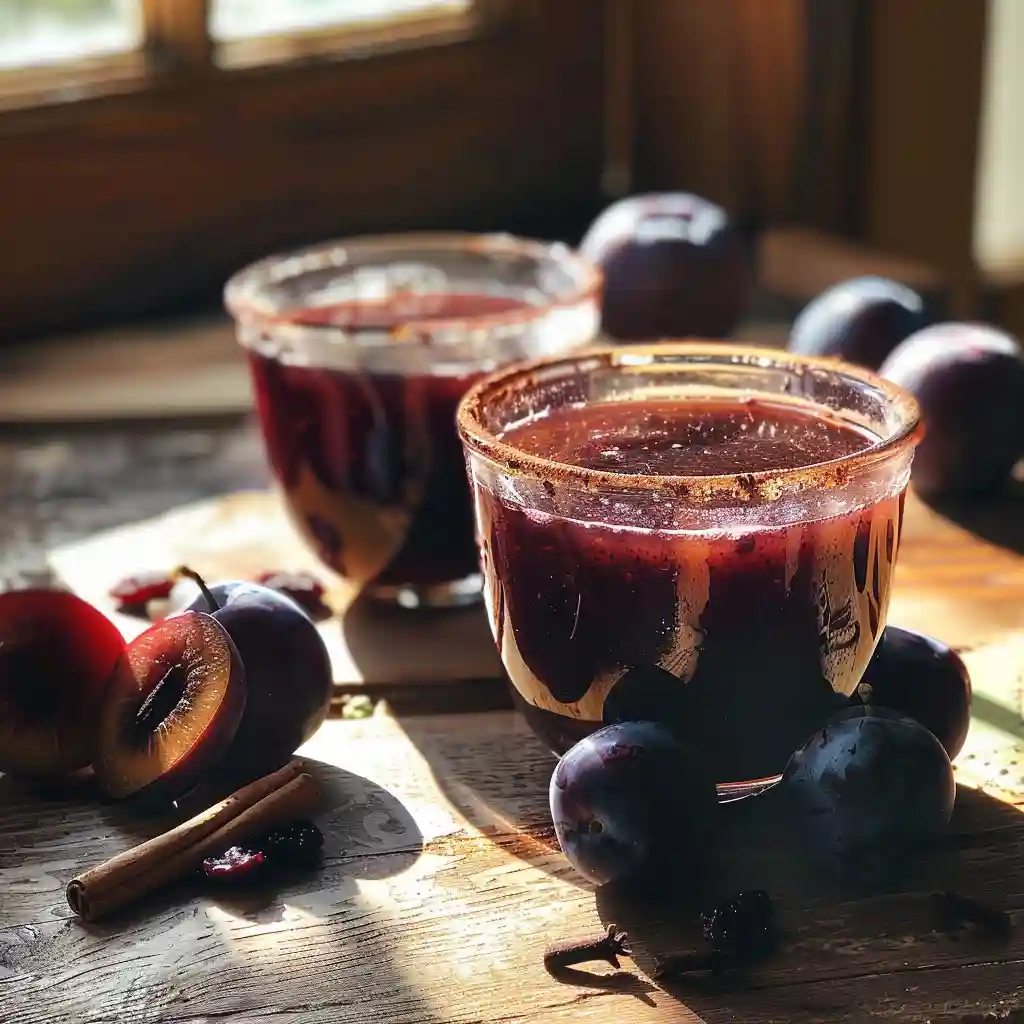Prune Juice vs Plum Juice has always been one of those kitchen mysteries that I never really questioned—until one summer in Morocco, when I was offered both at breakfast. That’s when it hit me: these juices aren’t just slightly different—they each bring their own taste, texture, and wellness perks to the table. And if you’ve ever stood in the grocery store wondering which bottle to grab, you’re not alone.
In this article, I’ll take you deep into the heart of prune juice vs plum juice, breaking down how each is made, how they differ nutritionally, and when you might reach for one over the other. From natural digestion support to flavor preferences and even how they mix into smoothies, this is my personal guide shaped by travel, trial, and kitchen discovery.
Looking for inspiration? Try this refreshing prune juice recipe I’ve tested many times—it’s simple, comforting, and naturally soothing.
Whether you’re here because of digestion concerns, health goals, or simple curiosity, you’re about to get the clear scoop—backed by personal experience, real use, and all the delicious detail.
Table of Contents
Understanding Prune Juice and Plum Juice
What Is Prune Juice?
Let’s kick things off with the basics—prune juice comes from dried plums, also known as prunes. It’s thick, smooth, and often described as syrupy. From my time experimenting with natural remedies during a trip to the countryside of Spain, I learned that prune juice is traditionally used to support digestion, especially thanks to its natural sorbitol and fiber content.
Unlike many juices that come straight from fresh fruit, prune juice is made by rehydrating dried prunes and then extracting the juice. This gives it a deep, almost earthy flavor that I’ve grown to love. I usually keep a bottle in the fridge for those moments when I need a comforting sip that feels grounding.
It’s also common to see prune juice in many homes with elderly folks—it’s been a go-to remedy for gentle relief for generations. And yes, it’s naturally sweet, without added sugars in most cases.
What Is Plum Juice?
Now, plum juice? Totally different vibe. This juice is made from fresh plums, usually red or purple varieties. It’s lighter, fruitier, and has more of that bright, tart-sweet profile. I remember sipping fresh plum juice in Turkey—it was vibrant and refreshing on a hot day.
Unlike prune juice, plum juice isn’t as thick. It tends to taste more like something you’d enjoy chilled on a sunny afternoon, not just when your digestion needs a nudge. When comparing prune juice vs plum juice, this contrast in texture and flavor really stands out.
Though not as widely bottled as prune juice, plum juice is becoming more popular for folks looking to enjoy fruit-forward drinks with natural antioxidants and a lighter feel.
The Bottom Line
So, are they the same? Absolutely not. While both come from the same fruit family, their processing methods, flavors, and effects on digestion are noticeably different. One is rehydrated and pressed from dried fruit, the other is a fresh, juicy sip that’s bursting with tart brightness. When looking at prune juice vs plum juice, knowing the difference can help you choose the right one for your taste—and your goals.

How Are They Made?
The Production Process of Prune Juice
Making prune juice is more than just blending fruit—it’s a process rooted in tradition. First, ripe plums are dried until they become chewy prunes. Then those prunes are soaked in hot water to rehydrate them. Once softened, they’re puréed and filtered to produce a rich, smooth liquid. What’s fascinating is that this method retains both the soluble fiber and sorbitol—two natural components that may help support digestion.
From my experience making it at home, the real magic happens during the heating phase. That slow simmer pulls out not just nutrients, but a warm, caramel-like flavor that you don’t get from fresh juice. I’ve even added a cinnamon stick or two while simmering—trust me, it’s comfort in a glass.
The Extraction Process of Plum Juice
Plum juice, on the other hand, is made from fresh, ripe plums, and the process is quicker. After washing and pitting the plums, they’re either cold-pressed or gently cooked and strained to extract the juice. The result is a brighter, thinner drink that holds onto the plum’s raw tanginess and fruity notes.
Unlike prune juice, this method doesn’t involve drying or rehydrating, so you keep more of the vitamin C and fresh flavor. When I made plum juice with local golden plums during a trip to California’s Central Valley, I was blown away by how floral and light the juice tasted.
Why the Process Matters
These methods influence not just taste, but nutritional benefits too. Rehydrated prunes offer more concentrated sweetness and fiber, while freshly pressed plums bring more hydration and brightness. That’s why your choice in the prune juice vs plum juice decision might depend on whether you’re looking for something therapeutic or simply thirst-quenching.
Don’t miss our warm prune juice and butter method—a cozy recipe passed down in many cultures for digestive ease.
Nutritional Differences Between Prune and Plum Juice
Key Vitamins and Minerals Comparison
If we line up prune juice vs plum juice side by side in terms of nutrition, the differences start popping out. Prune juice is typically richer in potassium, iron, and vitamin B6. That potassium boost alone can be helpful, especially for anyone trying to balance electrolytes. I’ve relied on it post-hike in Arizona more than once—it replenishes in a way that doesn’t feel artificial.
Plum juice, on the other hand, tends to have a higher content of vitamin C—since it’s made from fresh fruit, that makes sense. Vitamin C supports immune function, and when I need a light, refreshing drink during flu season, I go for plum juice every time.
Here’s a simple comparison to make it easy:
| Nutrient | Prune Juice | Plum Juice |
|---|---|---|
| Potassium | High | Moderate |
| Vitamin C | Low | High |
| Iron | Moderate | Low |
| Fiber | High (soluble) | Low |
Fiber Content and Its Digestive Role
Let’s talk about fiber. Prune juice still contains a decent amount of soluble fiber, even after straining. That’s one of the big reasons it’s often recommended to keep things moving—gently. When my digestion feels sluggish, a glass in the morning can really help.
Plum juice? Not so much. Since it’s made from fresh plums and strained more thoroughly, most of the fiber stays behind. It still hydrates beautifully, but doesn’t have that same digestive support.
So, when comparing prune juice vs plum juice, if fiber is your goal, prune juice clearly takes the lead.
Discover great ideas like this prune juice detox blend—a gentle option I often sip during seasonal resets.
Digestive Health: Which One Helps More?
Traditional Uses for Relieving Constipation
When it comes to constipation relief, prune juice is the longtime kitchen favorite. For years, I heard elders talk about its natural laxative effect, and now I understand why. It’s the sorbitol—a naturally occurring sugar alcohol—that may help draw water into the intestines, making bowel movements smoother. And it’s not just talk; I’ve experienced the difference firsthand, especially after long flights or diet changes.
Plum juice, by contrast, doesn’t pack the same punch. It’s hydrating and tasty but lacks the fiber and sorbitol levels that make prune juice a reliable choice in digestive routines. Some folks claim mild relief from plum juice due to its hydration factor, but in my experience, it’s far gentler—and not always effective on its own.
When it comes down to prune juice vs plum juice for digestive health, the winner is pretty clear if you’re after consistent results.
Check out our soothing hot buttered prune juice—a warm recipe I turn to whenever I need extra digestive comfort.
Personal Experience with Both for Gut Health
I’ve tried both juices across different seasons and situations. During a winter cleanse, I relied on prune juice daily—it grounded me, kept digestion regular, and helped reduce that heavy feeling. Plum juice? I use it more like a refreshing pick-me-up, especially when I don’t need any digestive help but want something fruity and light.
So, when you’re considering prune juice vs plum juice for gut health, think about your body’s needs in the moment. Both have their place—but their effects are definitely not the same.
Don’t miss our prune juice butter bomb—a nighttime ritual I learned from a friend’s grandmother that helps calm the gut.
Taste, Texture, and Usage
Flavor Profile of Prune Juice vs Plum Juice
Taste can be deeply personal, but here’s my honest take on the flavor difference between prune juice vs plum juice. Prune juice has a deep, mellow sweetness with notes that remind me of caramel and raisins. It’s thick, almost velvety. Some people call it earthy, but to me, it’s soothing—especially warm. It’s the kind of flavor that feels comforting, like a cozy blanket after a long day.
Plum juice, on the flip side, is light, crisp, and tangy. Its sweetness is fresher, and the acidity balances things out beautifully. I’ve had it chilled during summer BBQs, and it’s incredibly thirst-quenching. If prune juice feels like a warm hug, plum juice is a splash of sunshine.
How I’ve Used Both in Smoothies and Recipes
I’ve had fun blending both juices into my recipes. Prune juice works great as a base for smoothies that lean into warm spices—think cinnamon, nutmeg, or even a dash of cardamom. One fall morning, I blended it with almond milk, banana, and a hint of ginger—it tasted like dessert, but felt like nourishment.
Plum juice, however, shines in fruit-forward blends. I’ve mixed it with berries, mint, or even green apple for a refreshing detox smoothie. It also pairs well with sparkling water for a healthy mocktail I often serve to guests.
When it comes to experimenting in the kitchen, the prune juice vs plum juice conversation adds variety and flavor flexibility.
Want to try a classic twist? Don’t miss our natural zepbound drink recipe—perfect when you’re craving something both beneficial and bright.
Ultimately, I keep both in my fridge, because flavor moods change just like seasons. Each juice has its place in my kitchen—and in my routine.
Health Benefits and Concerns
Antioxidant Content and Immunity
Both prune juice and plum juice bring unique wellness perks, especially when it comes to natural antioxidants. Prune juice is rich in polyphenols—compounds that may support heart health and reduce oxidative stress. I’ve leaned on it during colder months when I want something comforting that also feels restorative.
Plum juice, being made from fresh fruit, often contains higher levels of vitamin C, which supports immune function. When I’m feeling run down or on the edge of a cold, plum juice is my go-to morning drink. It’s tart, refreshing, and seems to wake up my whole system.
And yes, both juices are naturally hydrating and rich in plant-based nutrients—just in slightly different ways.
When to Avoid Prune or Plum Juice
While both juices offer wellness support, they’re not ideal for everyone all the time. For example, I once drank prune juice two days in a row during a stressful week and—let’s just say—I spent more time near the bathroom than I wanted. Its natural laxative effect, while helpful, can be too much if overdone.
Plum juice is generally safer for daily drinking but can still cause digestive upset if consumed in large quantities due to its fruit sugar content.
It’s important to listen to your body. If you have diabetes, IBS, or are on certain medications, speak with a professional before adding large amounts of either juice to your routine.
Looking for a safe, easy start? Try our natural zepbound recipe—light on the gut, rich in benefits, and gentle enough for most folks.
Remember: These juices aren’t cure-alls. They’re traditional tools, and how they work depends on your unique body.
Storage, Shelf Life, and Availability
How Long They Last and How to Store Them
When it comes to juice shelf life, prune juice wins the longevity game. Since it’s pasteurized and made from dried fruit, it tends to last longer—both opened and unopened. Once opened, you can keep it in the fridge for up to a week and it still holds its flavor. I usually store mine in a glass bottle and give it a quick shake before using, especially if I’ve made it myself.
Plum juice, being fresh and more delicate, spoils quicker. It should be refrigerated immediately and used within 2 to 3 days for peak taste. I learned this the hard way after leaving a homemade batch out too long—it turned tart in the wrong way.
If you want something that lasts a while and works as a pantry staple, prune juice fits the bill. But if you’re making fresh juice at home or picking it up at a farmer’s market, plum juice is your quick delight.
Where to Find the Best Quality Juices
Finding quality prune or plum juice isn’t too hard—if you know where to look. I’ve had good luck at health food stores, local co-ops, and even online retailers. Just make sure the label reads “100% juice” with no added sugars or preservatives.
Prune juice is easier to find year-round and is often available in both conventional and organic varieties. Plum juice? That one’s seasonal, unless you’re lucky enough to live near a plum orchard or make it yourself during peak summer.
Discover great ideas like our chia seed water recipe—another natural hydration option I always keep handy alongside juice blends.
My tip: when in doubt, go for cold-pressed and unfiltered versions for richer nutrients and real fruit taste. Trust your eyes—the cloudier the juice, the closer it is to the real thing.
Cost, Accessibility, and Popularity
Average Price and Seasonal Availability
When it comes to price and availability, prune juice has a clear edge. It’s sold in nearly every grocery store year-round. A standard bottle usually runs between $3 and $6, depending on whether it’s organic. I keep a bottle in my pantry because it’s affordable, easy to store, and always there when I need it.
Plum juice, though? That’s a bit trickier. Since it’s made from fresh plums and often isn’t mass-produced like prune juice, it can cost more—especially if it’s cold-pressed or locally sourced. During plum season, I like to make my own from scratch. Outside those few warm months, though, I’ve found it mostly in specialty stores or farmer’s markets, sometimes costing $7 to $10 for a smaller bottle.
For anyone on a budget or looking for something shelf-stable, prune juice is the smart pick. But for a rare, refreshing twist—especially in summer—plum juice feels like a treat worth savoring.
Which One Is Trending and Why
Over the past year, I’ve seen a rise in interest for both juices—but in different circles. Wellness blogs and gut-health advocates still rave about prune juice for its role in digestion. It’s the classic, trusted option that keeps its reputation strong.
But plum juice has quietly gained popularity in the clean eating and hydration community. Its fresh taste and antioxidant profile appeal to younger health-conscious folks who want something light yet functional.
Check out this ice water hack for weight loss—another trending sip I’ve tested that pairs beautifully with plum juice ice cubes!
In short: prune juice remains the staple, but plum juice is the rising star.
My Final Take as a Home Cook
Which One I Keep in My Fridge and Why
After years of cooking, traveling, and listening to my body, here’s my truth: I always have prune juice in the fridge. It’s reliable, soothing, and works like a charm whenever I feel off balance. I use it in warm drinks, smoothies, or even sipped solo after a heavy meal. It’s more than just juice—it’s part of my kitchen rhythm.
That said, plum juice holds a special place too. During peak summer, when plums are everywhere, I blend fresh batches for sipping on hot days. Its tart, bright flavor reminds me of orchard visits and warm afternoons with friends. It may not be my daily drink, but it’s a seasonal joy I look forward to every year.
When I think about prune juice vs plum juice, it’s less about one being better—it’s about what each one brings to the moment.
Best Moments to Enjoy Each Juice
Here’s how I choose between them:
- Morning routine: Prune juice with warm water and lemon
- Post-lunch refresh: Plum juice over ice with mint
- Digestive support: Prune juice in the evening
- Summer treat: Plum juice with berries or fizzy water
And when I want a little extra gut-loving warmth, I turn to our warm prune juice with butter, my personal favorite after a long day.
For me, prune juice vs plum juice isn’t a debate—it’s a balance. I’ve learned to appreciate both, one glass at a time.

Frequently Asked Questions
Are plum juice and prune juice the same?
No, they’re not the same. Plum juice is made from fresh plums, while prune juice is made from dried plums (prunes) that are rehydrated and pressed. The taste, texture, and nutritional content are different, too. Plum juice is lighter and tangier, while prune juice is richer, thicker, and traditionally used to support digestion. When comparing prune juice vs plum juice, the differences are clear in both flavor and function.
Is prune or plum better for constipation?
From my experience—and what many folks have shared—prune juice is the better choice for constipation. It contains sorbitol and soluble fiber, both of which may naturally support regular bowel movements. Plum juice, while hydrating, doesn’t have the same digestive impact. If you’re deciding between prune juice vs plum juice for gut relief, prune usually comes out ahead.
Is plum juice a natural laxative?
Plum juice may have mild effects due to its hydration and natural sugars, but it’s not considered a strong natural laxative. Prune juice, thanks to its sorbitol content, is traditionally used as a natural laxative and is often more effective for digestive support.
When shouldn’t you drink prune juice?
If you’re dealing with diarrhea, IBS flare-ups, or are on a low-fiber diet, you may want to avoid prune juice. It can be too stimulating for some people. I also avoid drinking too much during travel or before a big event—just to stay safe. Always listen to your body and, when needed, check in with a healthcare professional.
Conclusion
So, where do I land on the whole prune juice vs plum juice question? Honestly, both earn their spot in my kitchen—but for very different reasons. Prune juice is my go-to for comfort and digestive support. It’s thick, warm, and reliable—especially when my gut needs a little love. Plum juice, on the other hand, is my sunny-day refreshment. Bright, tangy, and perfect for those moments when I want a glass of something light and flavorful.
From personal experience, I’ve found that having both gives me flexibility. Whether I’m crafting a cozy winter drink or blending a summer detox smoothie, these juices each bring something unique to the table.
This recipe is shared for informational purposes and is not a substitute for medical advice.
Don’t miss our natural zepbound drink for weight loss—a blend that’s as vibrant as it is supportive.
If you’re curious about what works best for your body, try both. See how you feel. Taste, texture, and your gut might just guide the way.
Want more ideas like this? Follow me on Facebook or browse fresh wellness tips and drinks on Pinterest.








It is not possible to become uncircumcised, as circumcision is a surgical procedure that removes
the foreskin from the penis.
Visit my homepage; lisinopril brand
Right away I am ready to do my breakfast, after having my breakfast
coming again to read more news.
Also visit my blog: y 2mate
Thanks for your personal marvelous posting! I definitely enjoyed reading it,
you might be a great author.I will always bookmark your blog and may come back sometime soon.
I want to encourage you to ultimately continue your great work,
have a nice holiday weekend!
my web page ana4d